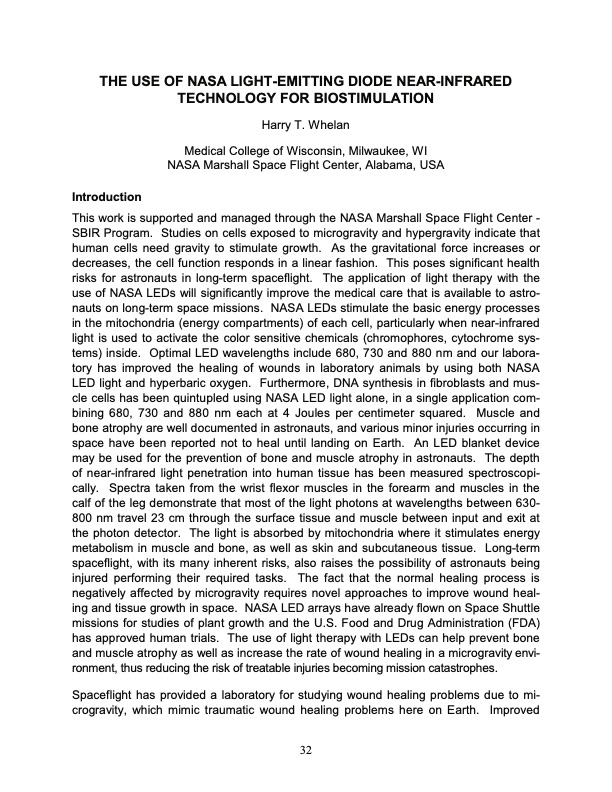
PDF Publication Title:
Text from PDF Page: 001
THE USE OF NASA LIGHT-EMITTING DIODE NEAR-INFRARED TECHNOLOGY FOR BIOSTIMULATION Introduction Harry T. Whelan Medical College of Wisconsin, Milwaukee, WI NASA Marshall Space Flight Center, Alabama, USA This work is supported and managed through the NASA Marshall Space Flight Center - SBIR Program. Studies on cells exposed to microgravity and hypergravity indicate that human cells need gravity to stimulate growth. As the gravitational force increases or decreases, the cell function responds in a linear fashion. This poses significant health risks for astronauts in long-term spaceflight. The application of light therapy with the use of NASA LEDs will significantly improve the medical care that is available to astro- nauts on long-term space missions. NASA LEDs stimulate the basic energy processes in the mitochondria (energy compartments) of each cell, particularly when near-infrared light is used to activate the color sensitive chemicals (chromophores, cytochrome sys- tems) inside. Optimal LED wavelengths include 680, 730 and 880 nm and our labora- tory has improved the healing of wounds in laboratory animals by using both NASA LED light and hyperbaric oxygen. Furthermore, DNA synthesis in fibroblasts and mus- cle cells has been quintupled using NASA LED light alone, in a single application com- bining 680, 730 and 880 nm each at 4 Joules per centimeter squared. Muscle and bone atrophy are well documented in astronauts, and various minor injuries occurring in space have been reported not to heal until landing on Earth. An LED blanket device may be used for the prevention of bone and muscle atrophy in astronauts. The depth of near-infrared light penetration into human tissue has been measured spectroscopi- cally. Spectra taken from the wrist flexor muscles in the forearm and muscles in the calf of the leg demonstrate that most of the light photons at wavelengths between 630- 800 nm travel 23 cm through the surface tissue and muscle between input and exit at the photon detector. The light is absorbed by mitochondria where it stimulates energy metabolism in muscle and bone, as well as skin and subcutaneous tissue. Long-term spaceflight, with its many inherent risks, also raises the possibility of astronauts being injured performing their required tasks. The fact that the normal healing process is negatively affected by microgravity requires novel approaches to improve wound heal- ing and tissue growth in space. NASA LED arrays have already flown on Space Shuttle missions for studies of plant growth and the U.S. Food and Drug Administration (FDA) has approved human trials. The use of light therapy with LEDs can help prevent bone and muscle atrophy as well as increase the rate of wound healing in a microgravity envi- ronment, thus reducing the risk of treatable injuries becoming mission catastrophes. Spaceflight has provided a laboratory for studying wound healing problems due to mi- crogravity, which mimic traumatic wound healing problems here on Earth. Improved 32PDF Image | THE USE OF NASA LED NEAR-INFRARED TECHNOLOGY FOR BIOSTIMULATION

PDF Search Title:
THE USE OF NASA LED NEAR-INFRARED TECHNOLOGY FOR BIOSTIMULATIONOriginal File Name Searched:
nasa-led-biostimulation.pdfDIY PDF Search: Google It | Yahoo | Bing
Cruise Ship Reviews | Luxury Resort | Jet | Yacht | and Travel Tech More Info
Cruising Review Topics and Articles More Info
Software based on Filemaker for the travel industry More Info
The Burgenstock Resort: Reviews on CruisingReview website... More Info
Resort Reviews: World Class resorts... More Info
The Riffelalp Resort: Reviews on CruisingReview website... More Info
| CONTACT TEL: 608-238-6001 Email: greg@cruisingreview.com | RSS | AMP |